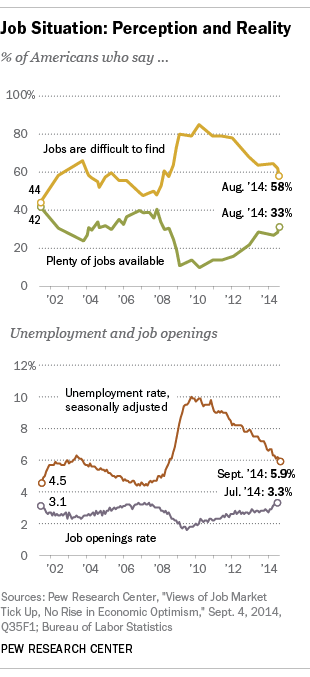
Americans may not be raging optimists when it comes to finding work — perhaps “skeptical realists” is closer to the mark — but their self-assessment of the job market tracks pretty closely with official unemployment statistics.
The nation’s seasonally adjusted unemployment rate fell to 5.9% in September, according to the Bureau of Labor Statistics figures out today. That represents a drop of 4.1 percentage points from the high of 10% recorded in October 2009 — although, as we’ve discussed before, some of that decline comes not from more people finding work but from more people dropping out of the labor force.
Since 2001, the Pew Research Center has been asking Americans for their views of job opportunities where they live. Those views don’t change quite as quickly as the official data might suggest they should — negative sentiment peaked in March 2010, when 85% of Americans said jobs were difficult to find. That figure has since fallen about a third, to 58% in August.
But the similar trendlines suggest that Americans have a good general sense of how job prospects are improving or weakening — even if, as results from our most recent news quiz suggest, they may not know precisely what the unemployment rate is. Only 33% correctly pegged the jobless rate at close to 6%; many more – 45% – thought it was closer to either 9% or 12%. (You can test your own knowledge of the news and compare yourself to other Americans.)
No matter what the national jobs data look like, most people perceive a challenging job market. Even in late 2006/early 2007, when unemployment was as low as 4.4%, more Americans called jobs difficult to find (49% in June 2007) than plentiful (39%). And the modest recent improvement in assessment of local labor conditions has done nothing to boost economic optimism generally: Just 21% rated economic conditions as excellent or good in our August survey, while 79% termed them only fair or poor.
The slowly rising level of employment optimism, as measured by the percentage of Americans saying plenty of jobs were available, finds its official analog in the job-openings rate. That metric, a different gauge of labor-market strength, expresses total job openings as a percentage of total employment plus openings. According to the BLS, there were nearly 4.7 million job openings in July, the most recent month for which data are available; that works out to a job-openings rate of 3.3%, the highest rate since June 2007. (Job-openings and labor turnover data for August will be released Oct. 7.)
